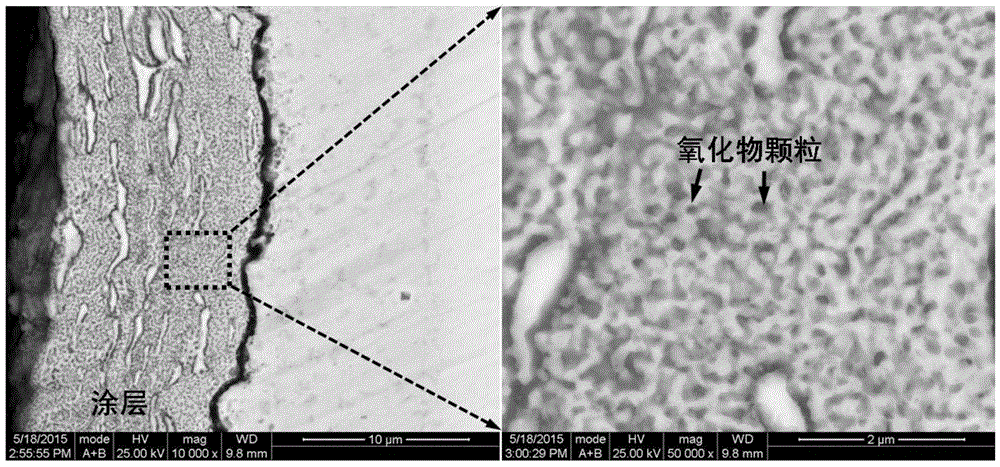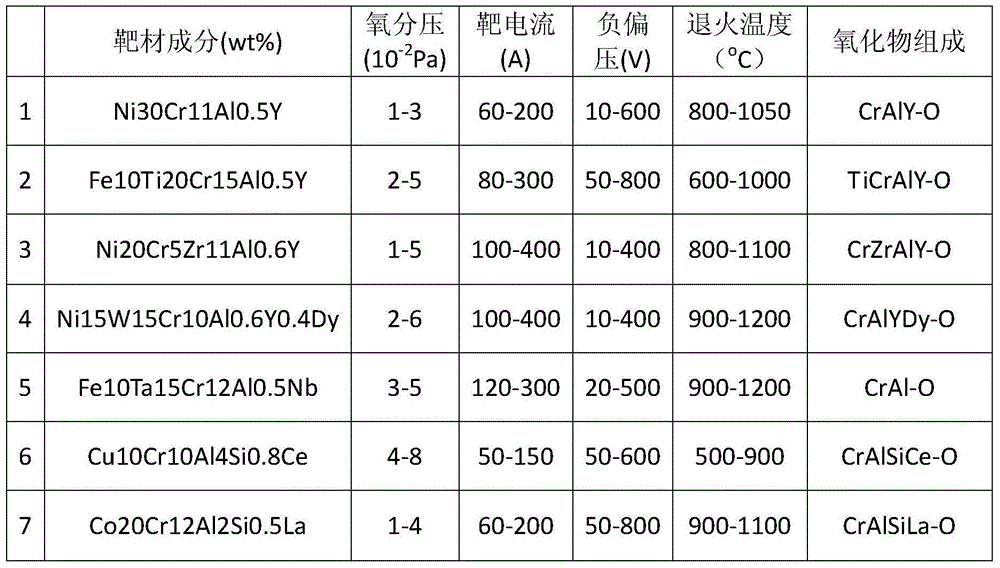In-situ preparation method of alloy coating reinforced through dispersion of microcrystalline oxide particles
A technology of oxide particles and dispersion strengthening, which is applied in metal material coating process, coating, molten spraying, etc., can solve the problems of low coating adhesion, agglomeration of oxide particles, poor controllability, etc., and achieve the goal of coating The effect of compact structure, controllable size and significant cost advantage
- Summary
- Abstract
- Description
- Claims
- Application Information
AI Technical Summary
Problems solved by technology
Method used
Image
Examples
Embodiment 1
[0024] This example illustrates the preparation method of the NiCo-based alloy coating strengthened by CrAlYSiHf oxide particle dispersion. First, install the NiCoCrAlYSiHf (Ni-25Co-25Cr-10Al-0.5Y-0.5Hf-1Si mass percent wt%) target on the cathode water-cooled target sleeve, hang the substrate test piece in front of the target, close the vacuum chamber door, and pump air; The vacuum degree of the coating chamber reaches 9×10 -3 When Pa or higher, feed oxygen to maintain the pressure of the vacuum chamber at 2×10 -2 Pa, ignite the cathode arc; apply a pulsed negative bias to the substrate for coating. The selection of the bias voltage amplitude is based on the density and bonding force of the deposited coating. The density and bonding force of the coating are slightly lower at 10-200V, but the deposition rate is less affected by the bias voltage, and the bias voltage of 400-800V can Increase the density and bonding force of the coating, but due to the effect of sputtering, the...
Embodiment 2
[0027] This example illustrates the preparation method of the aluminum oxide particle dispersion strengthened copper coating. First, install the copper-aluminum alloy (Cu-20Al, mass percent wt%) target on the cathode water-cooled target sleeve, hang the substrate test piece in front of the target, close the vacuum chamber door, and perform air extraction; the vacuum degree of the coating chamber reaches 9×10 -3 When Pa or higher, feed oxygen to maintain the pressure of the vacuum chamber at 6×10 -2 Pa, ignite the cathode arc; apply pulse negative bias voltage 200V to the substrate for coating. The magnitude of the arc current can affect the deposition rate of the coating, and the deposition rate is roughly linear with the magnitude of the current. In this example, 200A DC current is used. The pulse negative bias voltage applied to the substrate has a frequency of 5 kHz and a duty cycle of 60%. Then, put the coated test piece into the vacuum annealing furnace and evacuate to ...
Embodiment 3
[0029] This example illustrates the preparation method of the nickel coating strengthened by the dispersion of chromium oxide particles. First, install the nickel-chromium alloy (Ni20-60Cr, mass percentage wt%) target on the cathode water-cooled target sleeve, hang the substrate test piece in front of the target, close the vacuum chamber door, and perform air extraction; the vacuum degree of the coating chamber reaches 9×10 -3 When Pa or higher, feed oxygen to maintain the pressure of the vacuum chamber at 2×10 -2 -6×10 -2 Pa, ignite the cathodic arc; apply a pulse negative bias voltage of 50-200V to the substrate for coating, and the target with high chromium content can use a higher amplitude bias voltage. The magnitude of the arc current affects the deposition rate of the coating, and the deposition rate is roughly linear with the magnitude of the current. In this example, 100A DC current is used. The pulse negative bias voltage applied to the substrate has a frequency of...
PUM
| Property | Measurement | Unit |
|---|---|---|
| size | aaaaa | aaaaa |
| hardness | aaaaa | aaaaa |
Abstract
Description
Claims
Application Information
 Login to View More
Login to View More - R&D
- Intellectual Property
- Life Sciences
- Materials
- Tech Scout
- Unparalleled Data Quality
- Higher Quality Content
- 60% Fewer Hallucinations
Browse by: Latest US Patents, China's latest patents, Technical Efficacy Thesaurus, Application Domain, Technology Topic, Popular Technical Reports.
© 2025 PatSnap. All rights reserved.Legal|Privacy policy|Modern Slavery Act Transparency Statement|Sitemap|About US| Contact US: help@patsnap.com


